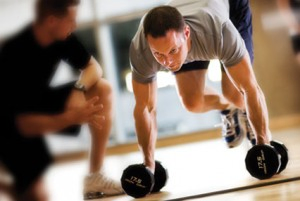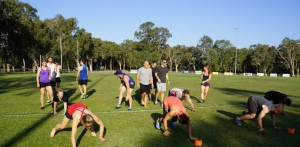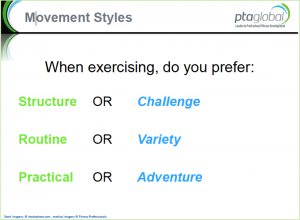Something has happened; it’s like some kind of new fangled cult. In every PT Studio and Big box gym on any given day you can witness small groups of people from all walks of life, being pushed and coerced to lift, twist, slam, carry and jump their way to fitness all under the skilled eye of a personal Trainer. These people are a new breed of fitness enthusiasts and everyone is scrambling to catch up with the trend! Small group training! And who can blame them After all, it is one of the industries top 10 Fitness trends for 2015.
So how do you run GREAT small group training session that keeps people coming back and bragging to their friends?
Successful trainers know that engaging with the individuals in the group as well as bringing the people in the group together creates the ultimate small group training experience.
In successful groups, the trainer’s role shifts from trainer to coach and clients gradually become empowered to modify their own effort, intensity and range of motion based on energy and fitness levels. [quotes style=”modern” align=”center” author=””]Giving clients ownership of their experience will encourage motivation (autonomy), which will ultimately lead to retention (mastery) and results (purpose).[/quotes]This is echoed in Dr Roy Sugarman’s book, Client Centered Training: A trainer and coach’s guide to motivating clients, Level 7 Psychology, 2014, where he highlights the key to behaviour change is following this principle of Autonomy, Mastery & Purpose.
So how can you make your small group session more personalized?
One SIMPLE way is to understand and cater your clients’ different Movement styles. This philosophy and information has been adapted from PTA Global’s world-class education and their proven Systems, Science and Tools ™.
Understanding your clients Movement Style?
It is clear that not all people like to ‘move’ or ‘exercise’ in the same way. Think about it for a minute, some people despise washing dishes, while other people don’t mind it at all and other people downright like washing dishes and will get some sort of sick enjoyment from it (who are these people anyway??). Now carry this concept over the fitness arena and telling a client who despises washing dishes, that they have to wash dishes three times a week and at moderate to high intensity (in order to see any benefits) and well, it is no wonder we have such high attrition rates in our industry. People will just stop coming and find any excuse under the sun to not (have to wash dishes anymore).
If on the other hand you can deliver or serve up movement or exercise in a manner they like it, then they will keep coming back for more and more.
So, what is your client Movement Style. In order to work out someone’s Movement Style, ask them the following questions:
If they answered with Structure, Routine and Practical – then they would be considered to have more of a TRADITIONAL movement style.
If on the other hand, they answered with Challenge, Variety and Adventure – then they would be considered to have a PROGRESSIVE movement style.
If they answered with a combination of both (i.e. sometime they like Structure and other times they like Challenge or they like Routine and Adventure) then they would be considered to have a HYBRID movement style.
So now lets take a deeper dive into each movement style:
TRADITIONAL clients

PROGRESSIVE clients

HYBRID clients
Hybrid Clients — They like a bit of both. They enjoy some component of each of the Traditional client and the Progressive client styles and thus it means you can pretty much do anything with them. Some days they may want a good leg session with some heavy squats and lunges (Traditional). While on other days they’ll want to play and get a little funky with their movement (Progressive). Of course Hybrids can sit at different places along the movement spectrum so it is critical to gather feedback from them to work out if they sit more on the Traditional side or Progressive side? Simply ask them what they like and don’t like and then tweak your programming accordingly.
“So in summary by asking your clients how they like their movement / exercise served up by asking them the simple questions mentioned above you will then be able to find out their preferred movement style. Once you know this you can then begin to tweak and alter your exercise selection and programming to deliver a more personalized session and service. As trainers begin to understand their role in a group, which in my opinion is not to merely instruct but to also facilitate the best possible fitness experience for individuals and the group, then their clients will bond and hold each other accountable, resulting in incredible connections, motivation and ultimately retention.”


